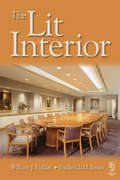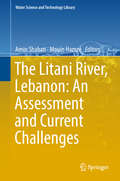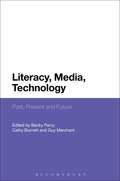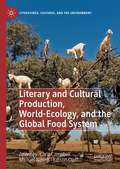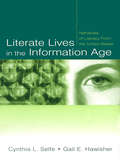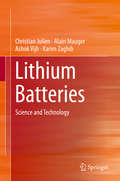- Table View
- List View
Listeria Monocytogenes: Methods and Protocols (Methods in Molecular Biology #2220)
by Edward M. Fox Hélène Bierne Beatrix StesslThis updated book explores a wide repertoire of tools and approaches that have been created, modified, and applied to the study of L. monocytogenes, forming the basis of our understanding of the bacterium today. Many of these key experimental techniques are gathered together herein. The volume presents aspects such as clinical disease and host-pathogen interactions, as well as the study of biofilms which present a significant challenge for control of the organism in the food processing environment. The topics covered in this edition also include sampling in order to isolate Listeria, methods for their identification and characterization, methods for gene manipulation, and methods for control of the organism. Written for the highly successful Methods in Molecular Biology series, chapters include introductions to their respective topics, lists of the necessary materials and reagents, step-by-step, readily reproducible laboratory protocols, and tips on troubleshooting and avoiding known pitfalls. Authoritative and up-to-date, Listeria monocytogenes: Methods and Protocols, Second Edition aims to contribute toward the harmonization of methods used to study this important bacterium, and to be of particular interest to Listeria research both in relation to food association and control as well as clinical microbiology.
Listeria monocytogenes: Methods and Protocols (Methods in Molecular Biology #1157)
by Kieran Jordan, Edward M. Fox and Martin WagnerListeria monocytogenes is still a major threat to public health. A new book in the Methods in Molecular Biology series, Listeria monocytogenes: Methods and Protocols addresses its titular pathogen with protocols and methodologies used in research to gain a better understanding of Listeria at a molecular level. The topics covered include sampling in order to isolate Listeria, methods for their identification and characterization, methods for gene manipulation and finally, methods for control of the organism. Written in the highly successful Methods in Molecular Biology series format, chapters include introductions to their respective subjects, lists of the necessary materials and reagents, step-by-step, readily reproducible laboratory protocols and tips on troubleshooting and avoiding known pitfalls.Vital and authoritative, Listeria monocytogenes: Methods and Protocols aims to contribute to the harmonization of the methods used in the field and will therefore benefit all those interested in Listeria research.
Listeria monocytogenes in the Food Processing Environment (SpringerBriefs in Food, Health, and Nutrition)
by Kieran Jordan Dara Leong Avelino Álvarez OrdóñezThis Brief focuses on Listeria monocytogenes, from isolation methods and characterization (including whole genome sequencing), to manipulation and control. Listeriosis, a foodborne disease caused by Listeria monocytogenes is a major concern for public health authorities. In addition, addressing issues relating to L. monocytogenes is a major economic burden on industry. Awareness of its ubiquitous nature and understanding its physiology and survival are important aspects of its control in the food processing environment and the reduction of the public health concern.
Listeria monocytogenes: Pathogenesis and Host Response
by Howard Goldfine Hao ShenDuring the past twenty years Listeria monocytogenes has emerged as one of the most intensely studied bacterial pathogens. New windows are constantly being opened into the complexity of host cell biology and the interplay of the signals connecting the various cells and organs involved in the host response. This volume includes research from studies at the molecular level on the pathogenesis of Listeria monocytogenes and the response of the host to its infections.
Lists Ideen zum deutschen Eisenbahnwesen
by Berta MeyerDieser Buchtitel ist Teil des Digitalisierungsprojekts Springer Book Archives mit Publikationen, die seit den Anfängen des Verlags von 1842 erschienen sind. Der Verlag stellt mit diesem Archiv Quellen für die historische wie auch die disziplingeschichtliche Forschung zur Verfügung, die jeweils im historischen Kontext betrachtet werden müssen. Dieser Titel erschien in der Zeit vor 1945 und wird daher in seiner zeittypischen politisch-ideologischen Ausrichtung vom Verlag nicht beworben.
Lit Interior
by Frederick H Jones William J FielderPresents an organised, comprehensive and easy to understand overview of the lighting design process. It covers every topic from the nature of light itself, through selecting the correct equipment, to preparing project plans and the finished design documents.Using a dummy example the student is taken through an entire project step by step where the full range of alternatives and design processes are illustrated. The easy to read conversational tone makes the novice feel at home with complex technical concepts and provides an excellent introduction to all newcomers to the subject. The book is ideal for those working in architecture, electrical engineering and interior design who will one day design lighting systems for others to build.A companion website runs alongside the book, at http://litinterior.com/, supporting distance learning projects, providing manufacturers data, calculation engines and downloadable courses for carrying our design exercises. The content of the courses will be linked directly to the book.Includes US codes and standards.
Lit Interior
by Frederick H Jones William J FielderPresents an organised, comprehensive and easy to understand overview of the lighting design process. It covers every topic from the nature of light itself, through selecting the correct equipment, to preparing project plans and the finished design documents.Using a dummy example the student is taken through an entire project step by step where the full range of alternatives and design processes are illustrated. The easy to read conversational tone makes the novice feel at home with complex technical concepts and provides an excellent introduction to all newcomers to the subject. The book is ideal for those working in architecture, electrical engineering and interior design who will one day design lighting systems for others to build.A companion website runs alongside the book, at http://litinterior.com/, supporting distance learning projects, providing manufacturers data, calculation engines and downloadable courses for carrying our design exercises. The content of the courses will be linked directly to the book.Includes US codes and standards.
The Litani River, Lebanon: An Assessment and Current Challenges (Water Science and Technology Library #85)
by Amin Shaban Mouin HamzéThis book presents a collection of chapters covering research on the Litani River Basin. The Litani River Basin occupies about a quarter of Lebanon's surface area, and it has recently been subject to severe geo-environmental conditions such as water contamination and decreased discharge. This motivated the Lebanese government to take action and start working on the remediation of the river. These actions are also supported by international organizations including the World Bank.
Literacy in the Digital University: Critical perspectives on learning, scholarship and technology (Research into Higher Education)
by Robin Goodfellow Mary R. LeaLiteracy in the Digital University is an innovative volume bringing together perspectives from two fields of enquiry and practice: ‘literacies and learning’ and ‘learning technologies’. With their own histories and trajectories, these fields have seldom overlapped either in practice, theory, or research. In tackling this divide head on, the volume breaks new ground. It illustrates how complementary and contrasting approaches to literacy and technology can be brought together in productive ways and considers the implications of this for practitioners working across a wide range of contexts. The book showcases work from well-respected authorities in the two fields in order to provide the foundations for new conversations about learning and practice in the digital university. It will be of particular relevance to university teachers and researchers, educational developers and learning technologists, library staff, university managers and policy makers, and, not least, learners themselves, particularly those studying at post-graduate level.
Literacy in the Digital University: Critical perspectives on learning, scholarship and technology (Research into Higher Education)
by Robin Goodfellow Mary R. LeaLiteracy in the Digital University is an innovative volume bringing together perspectives from two fields of enquiry and practice: ‘literacies and learning’ and ‘learning technologies’. With their own histories and trajectories, these fields have seldom overlapped either in practice, theory, or research. In tackling this divide head on, the volume breaks new ground. It illustrates how complementary and contrasting approaches to literacy and technology can be brought together in productive ways and considers the implications of this for practitioners working across a wide range of contexts. The book showcases work from well-respected authorities in the two fields in order to provide the foundations for new conversations about learning and practice in the digital university. It will be of particular relevance to university teachers and researchers, educational developers and learning technologists, library staff, university managers and policy makers, and, not least, learners themselves, particularly those studying at post-graduate level.
Literacy, Media, Technology: Past, Present and Future
by Becky Parry Cathy Burnett Guy MerchantLiteracy, Media, Technology considers the continued significance of popular culture forms such as postcards, film, television, games, virtual worlds and social media for educators. Following multiple pathways through technological innovation, the contributors reflect on the way in which digital and portable devices lead to new and emerging forms of reading, participating and creating. Rejecting linear conceptualisations of progression, they explore how time is not linear as technological advances are experienced in multiple ways linked to different personal, social, political and economic trajectories. The contributors describe a range of practices from formal and informal education spaces and interrogate some of the continuities and discontinuities associated with literacy, media and technology at a time when rapidly evolving communicative practices often meet intransigence in educational systems. The chapters adopt diverse forms: historical perspectives, personal story and reflection, project reports, document analysis, critical reviews of resources, ethnographic accounts, and analyses of meaning-making within and beyond educational institutions. Together, they provide multiple insights into the diverse and fluid relationships between literacy, media, technology, and everyday life, and the many ways in which these relationships are significant to educational research and practice.
Literacy, Media, Technology: Past, Present and Future
by Becky Parry Cathy Burnett Guy MerchantLiteracy, Media, Technology considers the continued significance of popular culture forms such as postcards, film, television, games, virtual worlds and social media for educators. Following multiple pathways through technological innovation, the contributors reflect on the way in which digital and portable devices lead to new and emerging forms of reading, participating and creating. Rejecting linear conceptualisations of progression, they explore how time is not linear as technological advances are experienced in multiple ways linked to different personal, social, political and economic trajectories. The contributors describe a range of practices from formal and informal education spaces and interrogate some of the continuities and discontinuities associated with literacy, media and technology at a time when rapidly evolving communicative practices often meet intransigence in educational systems. The chapters adopt diverse forms: historical perspectives, personal story and reflection, project reports, document analysis, critical reviews of resources, ethnographic accounts, and analyses of meaning-making within and beyond educational institutions. Together, they provide multiple insights into the diverse and fluid relationships between literacy, media, technology, and everyday life, and the many ways in which these relationships are significant to educational research and practice.
Literacy Moves On: Using Popular Culture, New Technologies and Critical Literacy in the Primary Classroom
by Janet EvansThis book looks at the changing nature of literacy and at the way in which new and different literacies are emerging in the first part of the 21st century. It considers how children are shaping and being shaped by these changes, it also looks at how teachers need to bridge-the-gap between children's out of school interests and school based curriculum demands. This edited collection, which features chapters by international experts and voices in the field, aims to: Take a closer look at (and demystify) some of the influences on literacy in the 21st century e.g. popular culture, multi-modal texts, email, text messaging and critical literacy. Enhance teachers' awareness of these developments and show how they can use them to improve the literacy skills of their pupils. Show, through the Implications for Practice sections, how teachers can find different but straightforward ways of linking children's personal, out-of-school interests with the demands of the school curriculum.
Literacy Moves On: Using Popular Culture, New Technologies and Critical Literacy in the Primary Classroom
by Janet EvansThis book looks at the changing nature of literacy and at the way in which new and different literacies are emerging in the first part of the 21st century. It considers how children are shaping and being shaped by these changes, it also looks at how teachers need to bridge-the-gap between children's out of school interests and school based curriculum demands. This edited collection, which features chapters by international experts and voices in the field, aims to: Take a closer look at (and demystify) some of the influences on literacy in the 21st century e.g. popular culture, multi-modal texts, email, text messaging and critical literacy. Enhance teachers' awareness of these developments and show how they can use them to improve the literacy skills of their pupils. Show, through the Implications for Practice sections, how teachers can find different but straightforward ways of linking children's personal, out-of-school interests with the demands of the school curriculum.
Literary and Cultural Production, World-Ecology, and the Global Food System (Literatures, Cultures, and the Environment)
by Chris Campbell Michael Niblett Kerstin OloffLiterary and Cultural Production, World-Ecology, and the Global Food System marks a significant intervention into the field of literary food studies. Drawing on new work in world literature, cultural studies, and environmental studies, the essays gathered here explore how literary and cultural texts have represented and responded to the global food system from the late nineteenth century to the present day. Covering topics such as the impact of colonial monocultures and industrial agriculture, enclosure and the loss of the commons, the meatification of diets, the toxification of landscapes, and the consequences of climate breakdown, the volume ranges across the globe, from Thailand to Brazil, Cyprus to the Caribbean. Whether it is anxieties over imported meat in late Victorian Britain, labour struggles on Guatemalan banana plantations, or food dependency in Puerto Rico, the contributors to this volume show how fiction, poetry, drama, film, and music have critically explored and contributed to food cultures worldwide.
Literary Heterogenesis: Diagrammatic Dynamics. The Interplay Between the Virtual and the Actual (Lecture Notes in Morphogenesis)
by Noëlle BattThis book advances a new interdisciplinary approach that engages with the concepts of science and literature through the mediation of philosophy (with a focus on the ideas of Gilbert Simondon and Gilles Deleuze). It investigates in innovative ways the multifaceted dimensions of creation, of genesis, considered here in artistic and mathematical terms as “heterogenesis”. The dialogic interaction among the three domains generates a renewed analysis of poems selected in the work of particularly inventive poets, both French and American—Emily Dickinson, e.e. cummings and Francis Ponge—as well as the artwork of Pierre Soulages, Anna-Eva Bergman and Cy Twombly. Literary Heterogenesis. Diagrammatic Dynamics. The Interplay of the Virtual and the Actual will interest specialists of mathematics, physics, literary theory and criticism, philosophy, and epistemology. It will also attract any curious mind drawn to the bridging of disciplines and the concepts of the two cultures.
Literate Lives in the Information Age: Narratives of Literacy From the United States
by Cynthia L. Selfe Gail E. HawisherThis book chronicles the development of electronic literacies through the stories of individuals with varying backgrounds and skills. Authors Cynthia L. Selfe and Gail E. Hawisher employ these stories to begin tracing technological literacy as it has emerged over the last few decades within the United States. They selected 20 case studies from the corpus of more than 350 people who participated in interviews or completed a technological literacy questionnaire during six years of their study. The book is organized into seven chapters that follow the 20 participants in their efforts to acquire varying degrees of technological literacy. Each chapter situates the participants' life-history accounts in the cultural ecology of the time, tracing major political, economic, social, and educational events, factors, and trends that may have influenced--and been influenced by--literacy practices and values. These literacy histories are richly sown with information that can help those in composition and writing studies situate the processes of acquiring the literacies of technology in specific cultural, material, educational, and familial contexts. These case studies provide initial clues about combinations of factors that affect--and are affected by--technological literacy acquisition and development. The first-hand accounts presented here offer, in abundant detail, everyday literacy experiences that can help educators, parents, policymakers, and writing teachers respond to today's students in more informed ways.
Literate Lives in the Information Age: Narratives of Literacy From the United States
by Cynthia L. Selfe Gail E. HawisherThis book chronicles the development of electronic literacies through the stories of individuals with varying backgrounds and skills. Authors Cynthia L. Selfe and Gail E. Hawisher employ these stories to begin tracing technological literacy as it has emerged over the last few decades within the United States. They selected 20 case studies from the corpus of more than 350 people who participated in interviews or completed a technological literacy questionnaire during six years of their study. The book is organized into seven chapters that follow the 20 participants in their efforts to acquire varying degrees of technological literacy. Each chapter situates the participants' life-history accounts in the cultural ecology of the time, tracing major political, economic, social, and educational events, factors, and trends that may have influenced--and been influenced by--literacy practices and values. These literacy histories are richly sown with information that can help those in composition and writing studies situate the processes of acquiring the literacies of technology in specific cultural, material, educational, and familial contexts. These case studies provide initial clues about combinations of factors that affect--and are affected by--technological literacy acquisition and development. The first-hand accounts presented here offer, in abundant detail, everyday literacy experiences that can help educators, parents, policymakers, and writing teachers respond to today's students in more informed ways.
Literature and sustainability: Concept, text and culture
by Adeline Johns-Putra John Parham Louise SquireThis edited collection brings together twelve essays by leading and upcoming scholars, the aim of which is to contribute critically to conceptions of sustainability from the standpoint of environmental literary scholarship. The book will be of interest to scholars and advanced students in ecocriticism and related fields.
The Lithium Air Battery: Fundamentals
by Nobuyuki Imanishi Alan C. Luntz Peter BruceLithium air rechargeable batteries are the best candidate for a power source for electric vehicles, because of their high specific energy density. In this book, the history, scientific background, status and prospects of the lithium air system are introduced by specialists in the field. This book will contain the basics, current statuses, and prospects for new technologies. This book is ideal for those interested in electrochemistry, energy storage, and materials science.
Lithium Batteries: Science and Technology (Nato Science Partnership Subseries: 3 Ser. #85)
by Christian Julien Alain Mauger Ashok Vijh Karim ZaghibThe book focuses on the solid-state physics, chemistry and electrochemistry that are needed to grasp the technology of and research on high-power Lithium batteries. After an exposition of fundamentals of lithium batteries, it includes experimental techniques used to characterize electrode materials, and a comprehensive analysis of the structural, physical, and chemical properties necessary to insure quality control in production. The different properties specific to each component of the batteries are discussed in order to offer manufacturers the capability to choose which kind of battery should be used: which compromise between power and energy density and which compromise between energy and safety should be made, and for which cycling life. Although attention is primarily on electrode materials since they are paramount in terms of battery performance and cost, different electrolytes are also reviewed in the context of safety concerns and in relation to the solid-electrolyte interface. Separators are also reviewed in light of safety issues. The book is intended not only for scientists and graduate students working on batteries but also for engineers and technologists who want to acquire a sound grounding in the fundamentals of battery science arising from the interaction of electrochemistry, solid state materials science, surfaces and interfaces.
Lithium Batteries: Science and Technology
by Gholam-Abbas Nazri Gianfranco PistoiaLithium Batteries: Science and Technology is an up-to-date and comprehensive compendium on advanced power sources and energy related topics. Each chapter is a detailed and thorough treatment of its subject. The volume includes several tutorials and contributes to an understanding of the many fields that impact the development of lithium batteries. Recent advances on various components are included and numerous examples of innovation are presented. Extensive references are given at the end of each chapter. All contributors are internationally recognized experts in their respective specialty. The fundamental knowledge necessary for designing new battery materials with desired physical and chemical properties including structural, electronic and reactivity are discussed. The molecular engineering of battery materials is treated by the most advanced theoretical and experimental methods.
Lithium Batteries and other Electrochemical Storage Systems (Iste Ser.)
by Christian Glaize Sylvie GeniesLithium batteries were introduced relatively recently in comparison to lead- or nickel-based batteries, which have been around for over 100 years. Nevertheless, in the space of 20 years, they have acquired a considerable market share – particularly for the supply of mobile devices. We are still a long way from exhausting the possibilities that they offer. Numerous projects will undoubtedly further improve their performances in the years to come. For large-scale storage systems, other types of batteries are also worthy of consideration: hot batteries and redox flow systems, for example. This book begins by showing the diversity of applications for secondary batteries and the main characteristics required of them in terms of storage. After a chapter presenting the definitions and measuring methods used in the world of electrochemical storage, and another that gives examples of the applications of batteries, the remainder of this book is given over to describing the batteries developed recently (end of the 20th Century) which are now being commercialized, as well as those with a bright future. The authors also touch upon the increasingly rapid evolution of the technologies, particularly regarding lithium batteries, for which the avenues of research are extremely varied. Contents Part 1. Storage Requirements Characteristics of Secondary Batteries Examples of Use 1. Breakdown of Storage Requirements. 2. Definitions and Measuring Methods. 3. Practical Examples Using Electrochemical Storage. Part 2. Lithium Batteries 4. Introduction to Lithium Batteries. 5. The Basic Elements in Lithium-ion Batteries: Electrodes, Electrolytes and Collectors. 6. Usual Lithium-ion Batteries. 7. Present and Future Developments Regarding Lithium-ion Batteries. 8. Lithium-Metal Polymer Batteries. 9. Lithium-Sulfur Batteries. 10. Lithium-Air Batteries. 11. Lithium Resources. Part 3. Other Types of Batteries 12. Other Types of Batteries. About the Authors Christian Glaize is Professor at the University of Montpellier, France. He is also Researcher in the Materials and Energy Group (GEM) of the Institute for Electronics (IES), France. Sylvie Geniès is a project manager at the French Alternative Energies and Atomic Energy Commission (Commissariat à l’Energie Atomique et aux Energies Alternatives) in Grenoble, France.
Lithium Batteries and other Electrochemical Storage Systems
by Christian Glaize Sylvie GeniesLithium batteries were introduced relatively recently in comparison to lead- or nickel-based batteries, which have been around for over 100 years. Nevertheless, in the space of 20 years, they have acquired a considerable market share – particularly for the supply of mobile devices. We are still a long way from exhausting the possibilities that they offer. Numerous projects will undoubtedly further improve their performances in the years to come. For large-scale storage systems, other types of batteries are also worthy of consideration: hot batteries and redox flow systems, for example. This book begins by showing the diversity of applications for secondary batteries and the main characteristics required of them in terms of storage. After a chapter presenting the definitions and measuring methods used in the world of electrochemical storage, and another that gives examples of the applications of batteries, the remainder of this book is given over to describing the batteries developed recently (end of the 20th Century) which are now being commercialized, as well as those with a bright future. The authors also touch upon the increasingly rapid evolution of the technologies, particularly regarding lithium batteries, for which the avenues of research are extremely varied. Contents Part 1. Storage Requirements Characteristics of Secondary Batteries Examples of Use 1. Breakdown of Storage Requirements. 2. Definitions and Measuring Methods. 3. Practical Examples Using Electrochemical Storage. Part 2. Lithium Batteries 4. Introduction to Lithium Batteries. 5. The Basic Elements in Lithium-ion Batteries: Electrodes, Electrolytes and Collectors. 6. Usual Lithium-ion Batteries. 7. Present and Future Developments Regarding Lithium-ion Batteries. 8. Lithium-Metal Polymer Batteries. 9. Lithium-Sulfur Batteries. 10. Lithium-Air Batteries. 11. Lithium Resources. Part 3. Other Types of Batteries 12. Other Types of Batteries. About the Authors Christian Glaize is Professor at the University of Montpellier, France. He is also Researcher in the Materials and Energy Group (GEM) of the Institute for Electronics (IES), France. Sylvie Geniès is a project manager at the French Alternative Energies and Atomic Energy Commission (Commissariat à l’Energie Atomique et aux Energies Alternatives) in Grenoble, France.
Lithium-Drifted Germanium Detectors: An Annotated Bibliography
by I. C. BrownridgeA lithium-drifted germanium detector is a semiconductor de vice which operates at liquid nitrogen temperature, and is used for detection of nuclear radiation, mostly gamma ray. The detection occurs when the y-ray undergoes an interaction in the intrinsic or I region of the semiconductor. The interaction results in the pro duction of charge carriers which are swept out by an electric field. This is accomplished by reverse biasing the detector with approxi mately 100 v/mm of intrinsic material. The total amount of charge swept out is proportional to the energy dissipated in the intrinsic region. This may include the total energy of the photon, but gen erally somewhat less. The Ge(Li) device is a semiconductor p-n device with a very large intrinsic region between the positive carrier region and the negative carrier region (P-I-N). The fabrication of this device consists of three major steps: the diffusion of the lithium into the p-type germanium to give an n-type surface region, the drifting process to obtain the intrinsic region as deeply as possible, and the surface preparation. There are numerous procedures for the various steps as well as criteria for material selection and the preparation of the materials.





